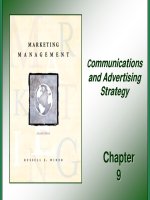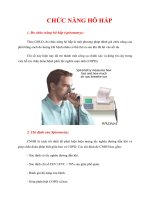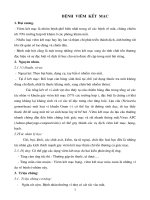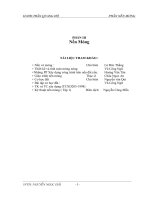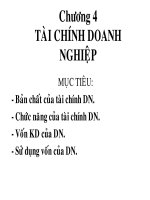Tài liệu Giáo trình: Marketing Management_ Chapter 05 docx
Bạn đang xem bản rút gọn của tài liệu. Xem và tải ngay bản đầy đủ của tài liệu tại đây (799.88 KB, 35 trang )
5 - 1
Chapter
Chapter
5
5
Organizational
Organizational
Buying
Buying
Behavior
Behavior
5 - 2
Key Learning Points
Key Learning Points
The key differences between consumer
The key differences between consumer
and industrial marketing.
and industrial marketing.
Market segmentation for marketing to
Market segmentation for marketing to
organizations.
organizations.
Understanding why organizational buyers
Understanding why organizational buyers
make decisions.
make decisions.
Understanding how organizations make
Understanding how organizations make
purchasing decisions.
purchasing decisions.
The importance of knowing where and
The importance of knowing where and
when such purchases are made.
when such purchases are made.
5 - 3
Product & Service
Product & Service
Decisions
Decisions
“
“
When a firm markets a product or
When a firm markets a product or
service to another organization, it
service to another organization, it
is called
is called
organizational marketing,
organizational marketing,
industrial marketing,
industrial marketing,
and since the
and since the
Internet boom of the late 1990s,
Internet boom of the late 1990s,
B
B
-
-
to
to
-
-
B (business
B (business
-
-
to
to
-
-
business)
business)
marketing.
marketing.
”
”
5 - 3
- Russell S. Winer
5 - 4
Organizational Buying
Organizational Buying
Buying Centers
Buying Centers
–
–
A group of individuals who are
A group of individuals who are
collectively involved in an
collectively involved in an
organizational buying decision.
organizational buying decision.
–
–
Key distinction between consumer and
Key distinction between consumer and
industrial purchase decision making as
industrial purchase decision making as
the dynamics of group decision making
the dynamics of group decision making
differ significantly from an individual
differ significantly from an individual
’
’
s
s
decision
decision
-
-
making process.
making process.
5 - 5
Industrial vs. Consumer
Industrial vs. Consumer
Marketing
Marketing
Key Differences Between Industrial
Key Differences Between Industrial
and Consumer Purchasing Behavior
and Consumer Purchasing Behavior
–
–
Demand is derived.
Demand is derived.
–
–
Industrial products are typically more
Industrial products are typically more
complex than consumer goods.
complex than consumer goods.
–
–
Buyer
Buyer
-
-
seller interdependence via the
seller interdependence via the
supply chain.
supply chain.
–
–
Industrial buying process is more
Industrial buying process is more
complex.
complex.
5 - 6
Product & Service
Product & Service
Decisions
Decisions
Key Decisions
Key Decisions
Who Are the Customers?
Who Are the Customers?
Segmentation Variables for
Segmentation Variables for
Business Markets
Business Markets
Operating
Operating
Variables
Variables
Purchasing
Purchasing
Approaches
Approaches
5 - 6
Situational
Situational
Factors
Factors
Personal
Personal
Characteristics
Characteristics
Demographic
Demographic
5 - 7
Product & Service
Product & Service
Decisions
Decisions
Key Decisions
Key Decisions
Who Are the Customers?
Who Are the Customers?
Segmentation for Medical
Segmentation for Medical
Equipment Manufacturer
Equipment Manufacturer
5 - 7
Number of Samples Processed Per Researcher
Number of
Researchers
Using
Equipment
Many Researchers
Few Samples
Few Researchers
Few Samples
Many Researchers
Many Samples
Few Researchers
Many Samples
5 - 8
Who Are the Customers?
Who Are the Customers?
Regardless of descriptors chosen,
Regardless of descriptors chosen,
resulting segments must behave
resulting segments must behave
differently & desire different benefits.
differently & desire different benefits.
Organizations make different types
Organizations make different types
of purchases, which can be
of purchases, which can be
classified into buy classes
classified into buy classes
–
–
Straight
Straight
rebuys
rebuys
–
–
Modified
Modified
rebuys
rebuys
–
–
New task purchases
New task purchases
5 - 9
Who Are the Customers?
Who Are the Customers?
Straight
Straight
Rebuy
Rebuy
Modified
Modified
Rebuy
Rebuy
New Task
New Task
Purchase
Purchase
Buy Classes
Buy Classes
Typical of frequently
Typical of frequently
purchased routine
purchased routine
items such as paper,
items such as paper,
toner, etc.
toner, etc.
Purchase decision
Purchase decision
complexity:
complexity:
simple
simple
Time frame:
Time frame:
short
short
Number of suppliers
Number of suppliers
considered:
considered:
one
one
5 - 10
Who Are the Customers?
Who Are the Customers?
Straight
Straight
Rebuy
Rebuy
Modified
Modified
Rebuy
Rebuy
New Task
New Task
Purchase
Purchase
Buy Classes
Buy Classes
Routine purchases
Routine purchases
that have changed in
that have changed in
some way (e.g., hard
some way (e.g., hard
drive size, processor
drive size, processor
speed, amount of
speed, amount of
computer RAM.)
computer RAM.)
Purchase decision
Purchase decision
complexity:
complexity:
moderate
moderate
Time frame:
Time frame:
medium
medium
Number of suppliers
Number of suppliers
considered:
considered:
few
few
5 - 11
Who Are the Customers?
Who Are the Customers?
Straight
Straight
Rebuy
Rebuy
Modified
Modified
Rebuy
Rebuy
New Task
New Task
Purchase
Purchase
Buy Classes
Buy Classes
Expensive, seldom
Expensive, seldom
-
-
purchased products
purchased products
(e.g. specialized
(e.g. specialized
consulting services)
consulting services)
Purchase decision
Purchase decision
complexity:
complexity:
complex
complex
Time frame:
Time frame:
long
long
Number of suppliers
Number of suppliers
considered:
considered:
many
many
5 - 12
Who Are the Customers?
Who Are the Customers?
Segmenting in Technology
Segmenting in Technology
-
-
Based
Based
Markets
Markets
–
–
Similar to consumers, some companies
Similar to consumers, some companies
will be earlier adopters of new
will be earlier adopters of new
technologies than will be others.
technologies than will be others.
–
–
Innovators are often used for beta
Innovators are often used for beta
testing, and can help new technologies
testing, and can help new technologies
be adopted.
be adopted.
–
–
However, the standard diffusion model
However, the standard diffusion model
must be modified for high
must be modified for high
-
-
tech markets.
tech markets.
5 - 13
Product & Service
Product & Service
Decisions
Decisions
High
High
-
-
tech
tech
companies rely
companies rely
on innovators to
on innovators to
help spread the
help spread the
word about new
word about new
technology.
technology.
Siebel
Siebel
uses
uses
endorsements
endorsements
from IBM, Bayer,
from IBM, Bayer,
and
and
Avaya
Avaya
for
for
their new CRM
their new CRM
software in the
software in the
ad at left.
ad at left.
5 - 13
5 - 14
Who Are the Customers?
Who Are the Customers?
Segmenting in Technology
Segmenting in Technology
-
-
Based
Based
Markets:
Markets:
The Chasm Model
The Chasm Model
–
–
The diffusion of innovations model
The diffusion of innovations model
indicates a smooth transition from one
indicates a smooth transition from one
stage to the next. The Chasm Model
stage to the next. The Chasm Model
recognizes this as a fallacy.
recognizes this as a fallacy.
•
•
Gap between visionaries (early adopters)
Gap between visionaries (early adopters)
and pragmatists (early majority) is called
and pragmatists (early majority) is called
the
the
chasm
chasm
.
.
•
•
Smaller gaps exist between other
Smaller gaps exist between other
categories.
categories.
5 - 15
Figure 5-2:
The Chasm Model
5 - 16
Who Are the Customers?
Who Are the Customers?
Marketing Research Implications
Marketing Research Implications
–
–
Data Collection
Data Collection
•
•
Little primary research is conducted;
Little primary research is conducted;
judgment often replaces hard data.
judgment often replaces hard data.
•
•
Syndicated research and secondary
Syndicated research and secondary
sources of information are used most often.
sources of information are used most often.
•
•
Trade associations and consulting firms
Trade associations and consulting firms
often provide data useful for segmentation
often provide data useful for segmentation
purposes.
purposes.
•
•
Figure 5.3 demonstrates behavioral data
Figure 5.3 demonstrates behavioral data
that may be useful for segmentation.
that may be useful for segmentation.
5 - 17
Figure 5-3:
Workstation Brand
Mindshare Report
5 - 18
Who Are the Customers?
Who Are the Customers?
Marketing Research Implications
Marketing Research Implications
–
–
Developing Target Markets
Developing Target Markets
•
•
Does the segmentation scheme explain
Does the segmentation scheme explain
differences in the behavioral variable of
differences in the behavioral variable of
interest?
interest?
•
•
How many customers are there?
How many customers are there?
•
•
What is the forecasted growth rate?
What is the forecasted growth rate?
•
•
Are there particular environmental factors
Are there particular environmental factors
associated with the segment that make it
associated with the segment that make it
more or less attractive?
more or less attractive?
•
•
What is your potential competitive position?
What is your potential competitive position?
5 - 19
Why Do Customers Buy?
Why Do Customers Buy?
Eight
Eight
-
-
step business
step business
-
-
to
to
-
-
business purchase
business purchase
decision process:
decision process:
–
–
Identify need
Identify need
–
–
Determine characteristics
Determine characteristics
–
–
Establish specifications
Establish specifications
–
–
Identify potential sources
Identify potential sources
–
–
Request proposals
Request proposals
–
–
Evaluate proposals
Evaluate proposals
–
–
Select supplier
Select supplier
–
–
Make
Make
postpurchase
postpurchase
evaluation
evaluation
5 - 20
Why Do Customers Buy?
Why Do Customers Buy?
Need recognition phase varies:
Need recognition phase varies:
–
–
New task purchase:
New task purchase:
•
•
Company recognizes they must buy something new
Company recognizes they must buy something new
to solve problem or fill need.
to solve problem or fill need.
•
•
Both external and internal parties stimulate need
Both external and internal parties stimulate need
recognition.
recognition.
–
–
Straight
Straight
rebuy
rebuy
:
:
•
•
Need is triggered when inventory is low.
Need is triggered when inventory is low.
–
–
Modified
Modified
rebuy
rebuy
:
:
•
•
Manager would be generally aware that different
Manager would be generally aware that different
options are available but would need to research
options are available but would need to research
alternatives.
alternatives.
5 - 21
Product & Service
Product & Service
Decisions
Decisions
Many ads in trade
Many ads in trade
magazines are
magazines are
feature, rather
feature, rather
than benefit
than benefit
oriented.
oriented.
Smart marketers
Smart marketers
create benefit
create benefit
-
-
oriented ads,
oriented ads,
particularly when
particularly when
targeting senior,
targeting senior,
non
non
-
-
technical
technical
management, as
management, as
in the ad at left.
in the ad at left.
5- 21
5 - 22
How Do Customers Make
How Do Customers Make
Purchase Decisions?
Purchase Decisions?
Members of the Buying Center:
Members of the Buying Center:
–
–
Initiator:
Initiator:
Person who first recognizes the need
Person who first recognizes the need
of the product.
of the product.
–
–
Influencers:
Influencers:
Influence the supplier selection
Influence the supplier selection
decision.
decision.
–
–
Decider:
Decider:
Individual who has ultimate authority
Individual who has ultimate authority
for a
for a
“
“
go
go
-
-
no
no
-
-
go
go
”
”
decision.
decision.
–
–
Purchaser:
Purchaser:
Person who actually authorizes
Person who actually authorizes
the payment.
the payment.
–
–
Users:
Users:
People who actually use the product.
People who actually use the product.
5 - 23
How Do Customers Make
How Do Customers Make
Purchase Decisions?
Purchase Decisions?
Business
Business
-
-
to
to
-
-
business marketers
business marketers
must understand patterns of
must understand patterns of
influence within organizations.
influence within organizations.
–
–
Salespeople need to identify key
Salespeople need to identify key
influencers and decision makers and
influencers and decision makers and
tailor presentation to needs of each.
tailor presentation to needs of each.
–
–
May require team
May require team
-
-
selling effort to be
selling effort to be
successful.
successful.
5 - 24
Product & Service
Product & Service
Decisions
Decisions
National Semiconductor
National Semiconductor
’
’
s website appeals to the
s website appeals to the
specific needs of different buying center members.
specific needs of different buying center members.
5 - 24
The parametric
The parametric
table feature
table feature
allows customers
allows customers
to sort products
to sort products
by arranging
by arranging
them in
them in
ascending or
ascending or
descending order
descending order
according to one
according to one
or more
or more
attributes.
attributes.
5 - 25
How Do Customers Make
How Do Customers Make
Purchase Decisions?
Purchase Decisions?
Characteristics of the product or service
Characteristics of the product or service
are determined after need recognition.
are determined after need recognition.
–
–
Typically stated in terms of benefits.
Typically stated in terms of benefits.
•
•
New task purchase situations typically require
New task purchase situations typically require
contact with potential suppliers.
contact with potential suppliers.
Establish specifications
Establish specifications
–
–
Needs are translated into specific product
Needs are translated into specific product
features.
features.
•
•
Salespeople are critical assets when developing
Salespeople are critical assets when developing
specifications for a new task purchase.
specifications for a new task purchase.

